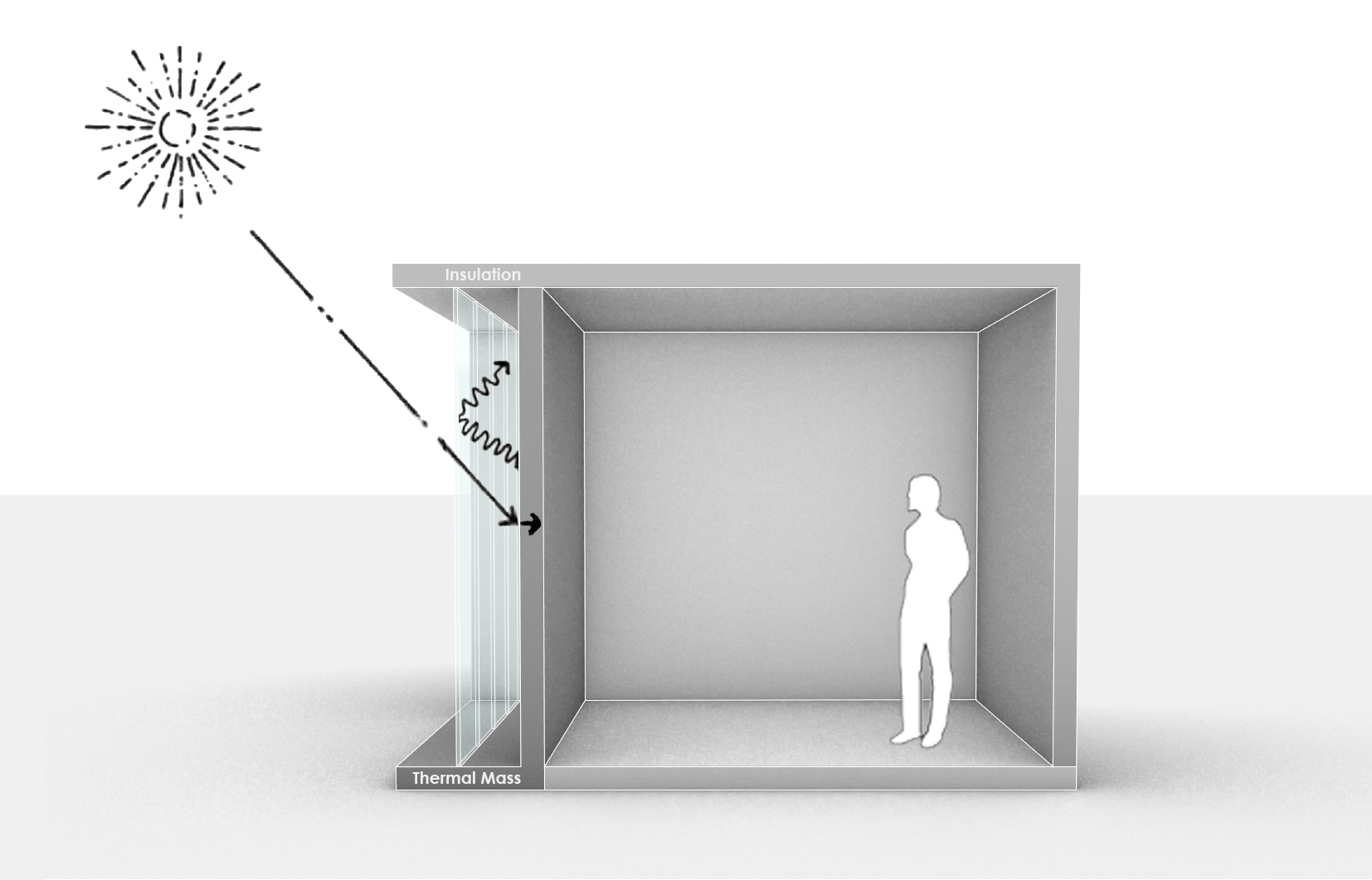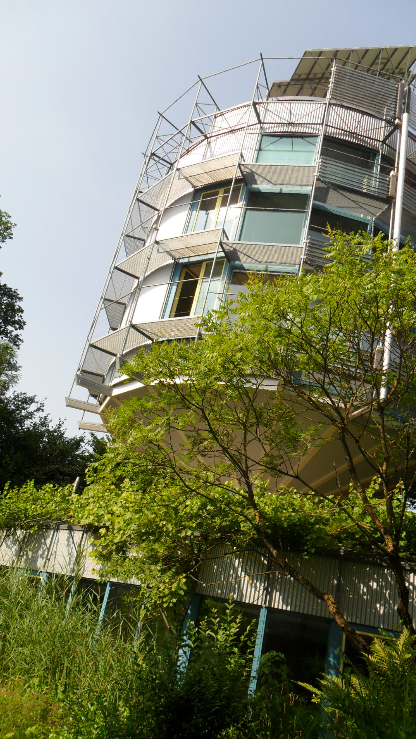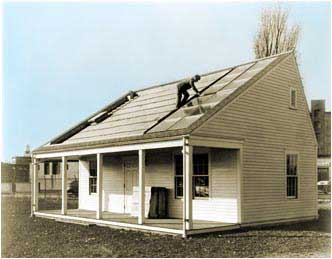|
Trombe Wall
A Trombe wall is a massive equator-facing wall that is painted a dark color in order to absorb thermal energy from incident sunlight and covered with a glass on the outside with an insulating air-gap between the wall and the glaze. A Trombe wall is a passive solar building design strategy that adopts the concept of indirect-gain, where sunlight first strikes a solar energy collection surface which covers thermal mass located between the Sun and the space. The sunlight absorbed by the mass is converted to thermal energy (heat) and then transferred into the living space. Trombe walls are also named mass walls, solar wall, or thermal storage wall. However, due to the extensive work of professor Félix Trombe and architect Jacques Michel in the design of passively heated and cooled solar structure, they are often called Trombe Walls. This system is similar to the air heater (as a simple glazed box on the south wall with a dark absorber, air space, and two sets of vents at top and botto ... [...More Info...] [...Related Items...] OR: [Wikipedia] [Google] [Baidu] |
Passive Solar Building
In passive solar building design, windows, walls, and floors are made to collect, store, reflect, and distribute solar energy, in the form of heat in the winter and reject solar heat in the summer. This is called passive solar design because, unlike active solar heating systems, it does not involve the use of mechanical and electrical devices. The key to designing a passive solar building is to best take advantage of the local climate performing an accurate site analysis. Elements to be considered include window placement and size, and glazing type, thermal insulation, thermal mass, and shading. Passive solar design techniques can be applied most easily to new buildings, but existing buildings can be adapted or "retrofitted". Passive energy gain ''Passive solar'' technologies use sunlight without active mechanical systems (as contrasted to ''active solar'', which uses thermal collectors). Such technologies convert sunlight into usable heat (in water, air, and thermal mass), cau ... [...More Info...] [...Related Items...] OR: [Wikipedia] [Google] [Baidu] |
Building Engineering
Architectural engineers apply and theoretical knowledge to the engineering design of buildings and building systems. The goal is to engineer high performance buildings that are sustainable, economically viable and ensure the safety health. Architectural engineering, also known as building engineering or architecture engineering, is an engineering discipline that deals with the technological aspects and multi-disciplinary. The responsibilities of an architectural engineer are designs, analyzing, and altering plans, or structures. They also assist team members with project objectives budgets and timelines. What it is required to be an architectural engineer is a bachelor's degree master's degree or/and professional engineering license and current knowledge of industry trends, technology, codes and regulation. From reduction of greenhouse gas emissions to the construction of resilient buildings, architectural engineers are at the forefront of addressing several major challenges of ... [...More Info...] [...Related Items...] OR: [Wikipedia] [Google] [Baidu] |
Sustainable Building
Green building (also known as green construction or sustainable building) refers to both a structure and the application of processes that are environmentally responsible and resource-efficient throughout a building's life-cycle: from planning to design, construction, operation, maintenance, renovation, and demolition. This requires close cooperation of the contractor, the architects, the engineers, and the client at all project stages.Yan Ji and Stellios Plainiotis (2006): Design for Sustainability. Beijing: China Architecture and Building Press. The Green Building practice expands and complements the classical building design concerns of economy, utility, durability, and comfort. Green building also refers to saving resources to the maximum extent, including energy saving, land saving, water saving, material saving, etc., during the whole life cycle of the building, protecting the environment and reducing pollution, providing people with healthy, comfortable and efficient u ... [...More Info...] [...Related Items...] OR: [Wikipedia] [Google] [Baidu] |
Solar Design
In passive solar building design, windows, walls, and floors are made to collect, store, reflect, and distribute solar energy, in the form of heat in the winter and reject solar heat in the summer. This is called passive solar design because, unlike active solar heating systems, it does not involve the use of mechanical and electrical devices. The key to designing a passive solar building is to best take advantage of the local climate performing an accurate site analysis. Elements to be considered include window placement and size, and glazing type, thermal insulation, thermal mass, and shading. Passive solar design techniques can be applied most easily to new buildings, but existing buildings can be adapted or "retrofitted". Passive energy gain ''Passive solar'' technologies use sunlight without active mechanical systems (as contrasted to ''active solar'', which uses thermal collectors). Such technologies convert sunlight into usable heat (in water, air, and thermal mass), cau ... [...More Info...] [...Related Items...] OR: [Wikipedia] [Google] [Baidu] |
Solar Architecture
Solar architecture is an architectural approach that takes in account the Sun to harness clean and renewable solar power. It is related to the fields of optics, thermics, electronics and materials science. Both active and passive solar housing skills are involved in solar architecture. The use of flexible thin-film photovoltaic modules provides fluid integration with steel roofing profiles, enhancing the building's design. Orienting a building to the Sun, selecting materials with favorable thermal mass or light dispersing properties, and designing spaces that naturally circulate air also constitute solar architecture. Initial development of solar architecture has been limited by the rigidity and weight of standard solar power panels. The continued development of photovoltaic (PV) thin film solar has provided a lightweight yet robust vehicle to harness solar energy to reduce a building's impact on the environment. History The idea of passive solar building design first app ... [...More Info...] [...Related Items...] OR: [Wikipedia] [Google] [Baidu] |
List Of Pioneering Solar Buildings
The following buildings are of significance in pioneering the use of solar powered building design: * MIT Solar House #1, Massachusetts, United States ( Hoyt C. Hottel & others, 1939) * Howard Sloan House, Glenview, Illinois, United States (George Fred Keck, 1940) * " Solar Hemicycle", near Madison, Wisconsin, United States (Frank Lloyd Wright, 1944) * Löf House, Boulder, Colorado, United States ( George Löf, 1945) * Rosenberg House, Tucson, Arizona, United States ( Arthur T. Brown, 1946) * MIT Solar House #2, United States, (Hoyt C. Hottel & others, 1947)''Solar Energy Applications in Houses'', F Jäger, Pergamon Press, * Peabody House ("Dover Sun House", MIT Solar House #6), Dover, Massachusetts, United States (Eleanor Raymond & Mária Telkes, 1948) * Henry P. Glass House, Northfield, Illinois, United States ( Henry P. Glass, 1948)''Henry P. Glass and World War II'', MIT Design Issues: Volume 22, Number 4 Autumn 2006 * Rose Elementary School, Tucson, Arizona, United States ... [...More Info...] [...Related Items...] OR: [Wikipedia] [Google] [Baidu] |
Barra System
The Barra system is a passive solar building technology developed by Horazio Barra in Italy. It uses a collector wall to capture solar radiation in the form of heat. It also uses the thermosiphon effect to distribute the warmed air through channels incorporated into the reinforced concrete floors, warming the floors and hence the building. Alternatively, in hot weather, cool nighttime air can be drawn through the floors to chill them in a form of air conditioning. Barra's are said to have more uniform north-south temperature distributions than other passive solar houses. Many successful systems were built in Europe, but Barra seems fairly unknown elsewhere. Passive solar collector To convert the sun's light into heat indirectly, a separate insulated space is constructed on the sunny side of the house walls. Looking at the outside, and moving through a cross section there is an outside clear layer. This was traditionally built using glass, but with the advent of cheap, robust ... [...More Info...] [...Related Items...] OR: [Wikipedia] [Google] [Baidu] |
Passive Solar Building Design
In passive solar building design, windows, walls, and floors are made to collect, store, reflect, and distribute solar energy, in the form of heat in the winter and reject solar heat in the summer. This is called passive solar design because, unlike active solar heating systems, it does not involve the use of mechanical and electrical devices. The key to designing a passive solar building is to best take advantage of the local climate performing an accurate site analysis. Elements to be considered include window placement and size, and glazing type, thermal insulation, thermal mass, and shading. Passive solar design techniques can be applied most easily to new buildings, but existing buildings can be adapted or "retrofitted". Passive energy gain ''Passive solar'' technologies use sunlight without active mechanical systems (as contrasted to ''active solar'', which uses thermal collectors). Such technologies convert sunlight into usable heat (in water, air, and thermal mass), cau ... [...More Info...] [...Related Items...] OR: [Wikipedia] [Google] [Baidu] |
19880412080NR Hopfgarten (Thüringen) Solarhaus Am Weinberg
File:1988 Events Collage.png, From left, clockwise: The oil platform Piper Alpha explodes and collapses in the North Sea, killing 165 workers; The USS Vincennes (CG-49) mistakenly shoots down Iran Air Flight 655; Australia celebrates its Australian Bicentenary, Bicentennial on January 26; The 1988 Summer Olympics are held in Seoul, South Korea; Soviet Union, Soviet troops begin their Soviet-Afghan War, withdrawal from Afghanistan, which is completed the 1989, next year; The 1988 Armenian earthquake kills between 25,000-50,000 people; The 8888 Uprising in Myanmar, led by students, protests the Burma Socialist Programme Party; A bomb explodes on Pan Am Flight 103, causing the plane to crash down on the town of Lockerbie, Scotland- the event kills 270 people., 300x300px, thumb rect 0 0 200 200 Piper Alpha rect 200 0 400 200 Iran Air Flight 655 rect 400 0 600 200 Australian Bicentenary rect 0 200 300 400 Pan Am Flight 103 rect 300 200 600 400 1988 Summer Olympics rect 0 400 200 600 8888 ... [...More Info...] [...Related Items...] OR: [Wikipedia] [Google] [Baidu] |
Félix Trombe
Felix Trombe (1906–1985) was a French engineer.Jean-Jacques Amigo, "Trombe (Félix)", in Nouveau Dictionnaire de biographies roussillonnaises, vol. 3 Sciences de la Vie et de la Terre, Perpignan, Publications de l'olivier, 2017, 915 p. () He was born in Nogent and died in Ganties. He is best known for his pioneering work in passive solar building design with the Trombe wall, which bears his name. He is also credited with hypothesizing passive daytime radiative cooling in 1967. Mont-Louis Solar Furnace In 1949 Trombe directed the construction of the experimental 50 kW Mont-Louis Solar Furnace in the Pyrénées-Orientales Pyrénées-Orientales (; ca, Pirineus Orientals ; oc, Pirenèus Orientals ; ), also known as Northern Catalonia, is a department of the region of Occitania, Southern France, adjacent to the northern Spanish frontier and the Mediterranean Sea ... for high temperature experiments in physics and chemistry. In 1962, a 1000 kW solar furna ... [...More Info...] [...Related Items...] OR: [Wikipedia] [Google] [Baidu] |
Half Trombe Wall
One half ( : halves) is the irreducible fraction resulting from dividing one by two or the fraction resulting from dividing any number by its double. Multiplication by one half is equivalent to division by two, or "halving"; conversely, division by one half is equivalent to multiplication by two, or "doubling". One half often appears in mathematical equations, recipes, measurements, etc. Half can also be said to be one part of something divided into two equal parts. For instance, the area ''S'' of a triangle is computed. :''S'' = × perpendicular height. One half also figures in the formula for calculating figurate numbers, such as triangular numbers and pentagonal numbers: : \frac and in the formula for computing magic constants for magic squares : M_2(n) = \frac \left(n^ + 1\right) The Riemann hypothesis states that every nontrivial complex root of the Riemann zeta function has a real part equal to . One half has two different decimal expansion ... [...More Info...] [...Related Items...] OR: [Wikipedia] [Google] [Baidu] |






